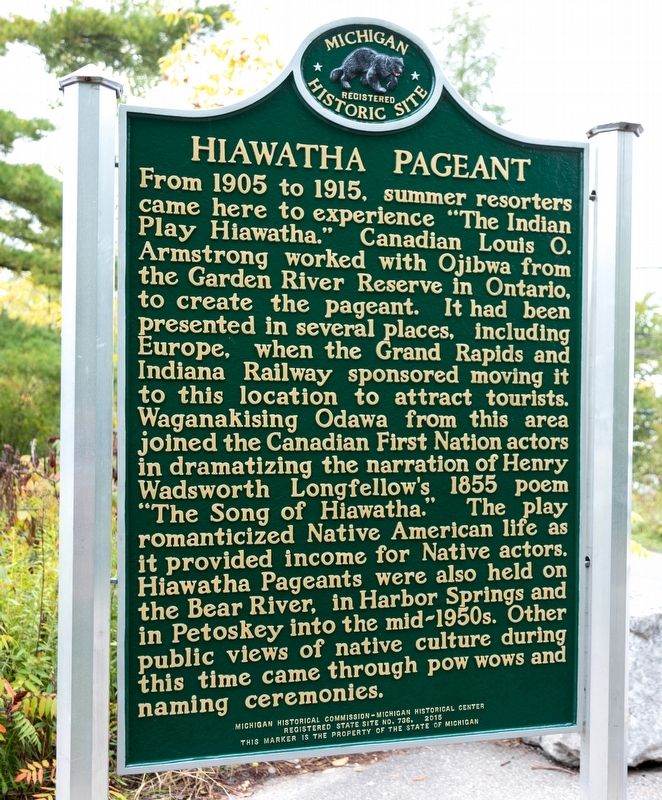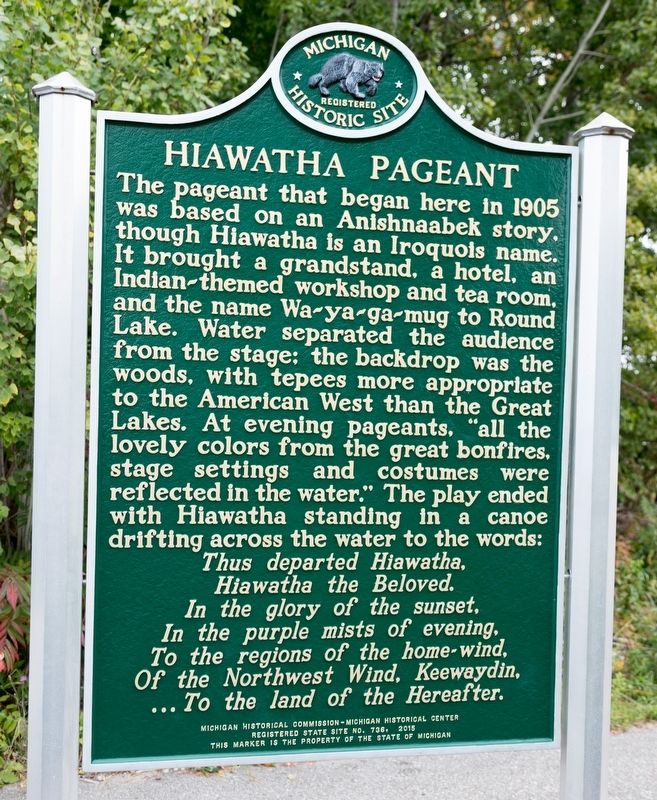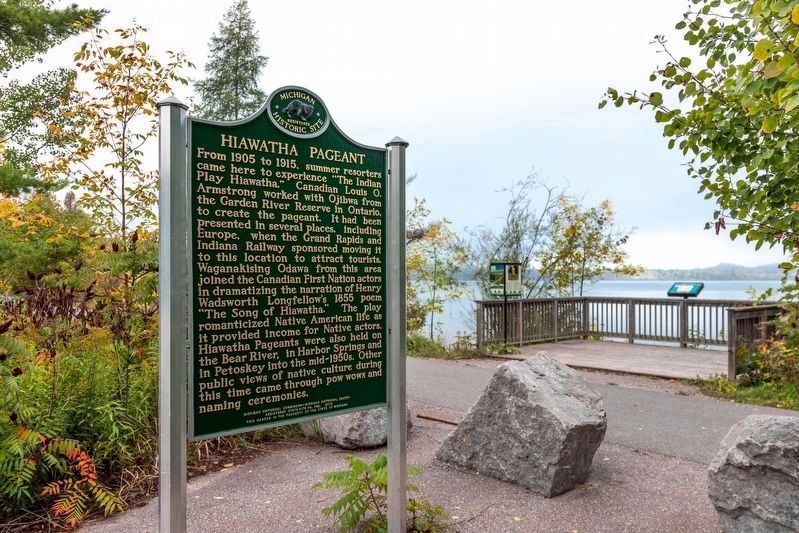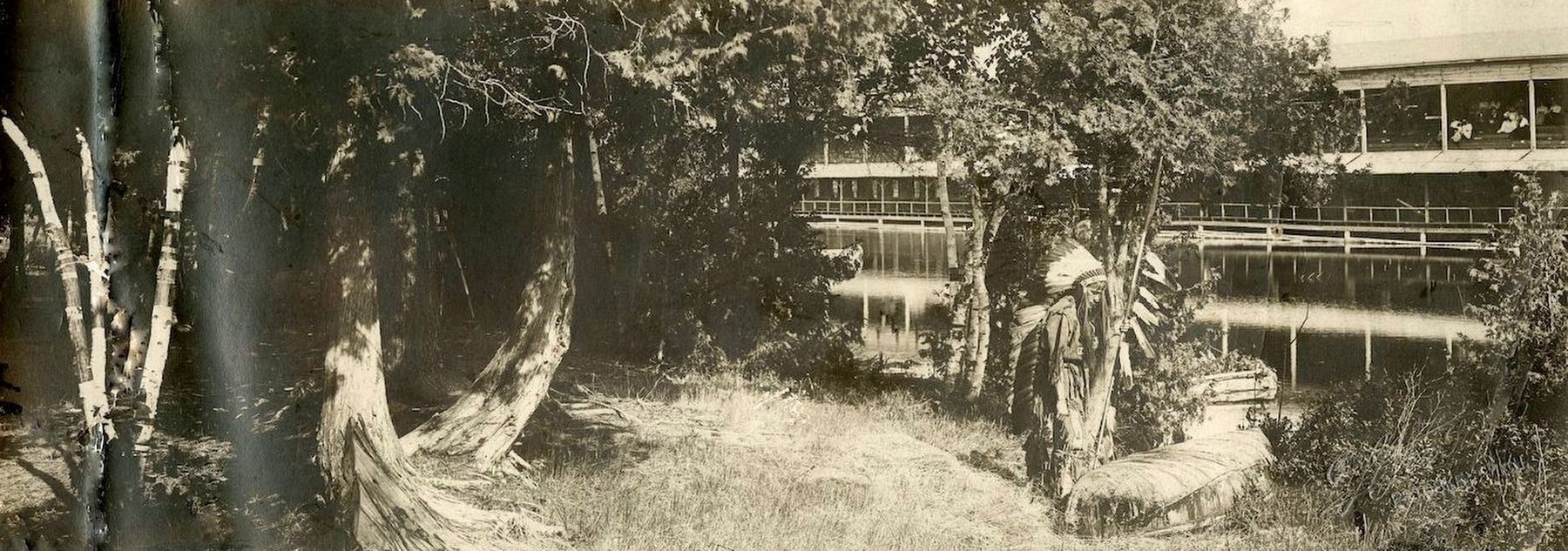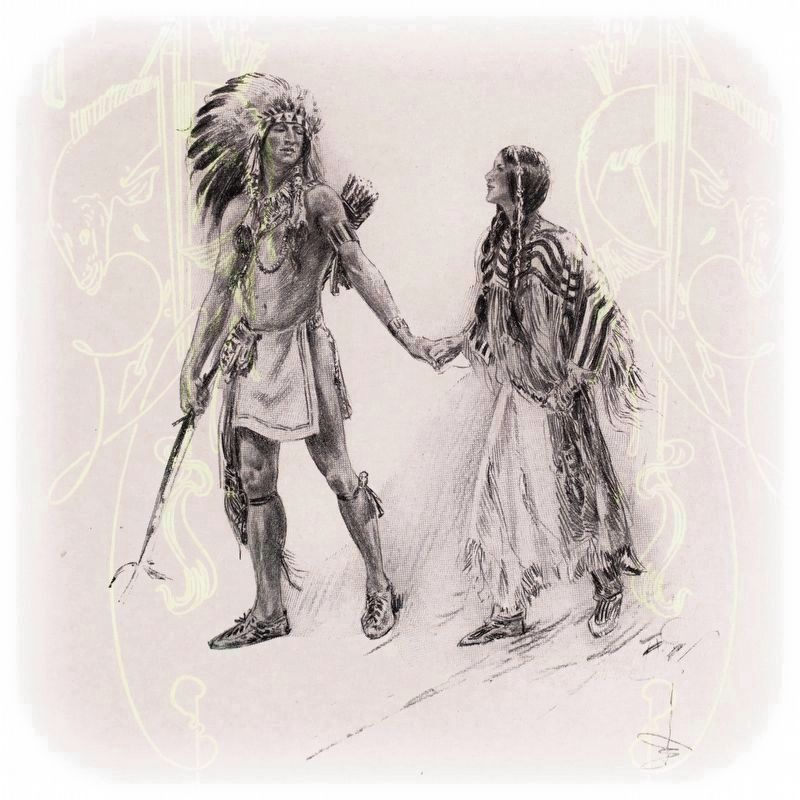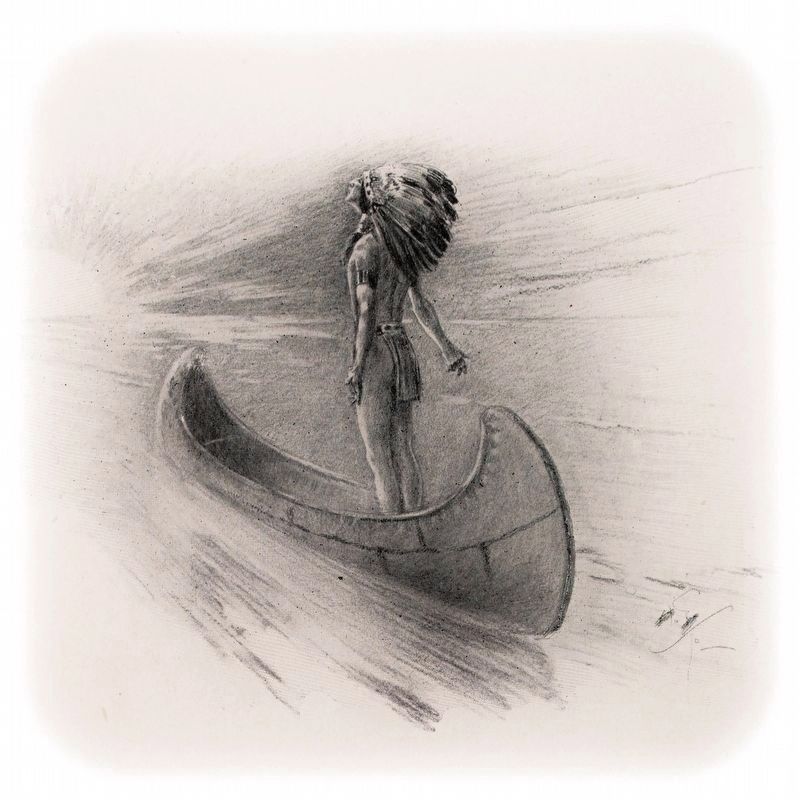Bay Harbor in Petoskey in Emmet County, Michigan — The American Midwest (Great Lakes)
Hiawatha Pageant
From 1905 to 1915, summer resorters came here to experience “The Indian Play Hiawatha.” Canadian Louis O. Armstrong worked with Ojibwa from the Garden River Reserve in Ontario, to create the pageant. It had been presented in several places, including Europe, when the Grand Rapids and Indiana Railway sponsored moving it to this location to attract tourists. Waganakising Odawa from this area joined the Canadian First Nation actors in dramatizing the narration of Henry Wadsworth Longfellow’s 1855 poem “The Song of Hiawatha.” The play romanticized Native American life as it provided income for Native actors. Hiawatha Pageants were also held on the Bear River, in Harbor Springs and in Petoskey into the mid-1950s. Other public views of native culture during this time came through pow wows and naming ceremonies.
The pageant that began here in 1905 was based on an Anishnaabek story, though Hiawatha is an Iroquois name. It brought a grandstand, a hotel, an Indian-themed workshop and tea room, and the name Wa-ya-ga-mug to Round Lake. Water separated the audience from the stage; the backdrop was the woods, with tepees more appropriate to the American West than the Great Lakes. At evening pageants, “all the lovely colors from the great bonfires, stage settings and costumes were reflected in the water.” The play ended with Hiawatha standing in a canoe drifting across the water to the words:
Thus departed Hiawatha,
Hiawatha the Beloved.
In the glory of the sunset,
In the purple mists of evening,
To the regions of the home-wind,
Of the Northwest Wind, Keewaydin,
… To the land of the Hereafter.
Erected 2015 by Michigan Historical Commission - Michigan Historical Center. (Marker Number 736.)
Topics. This historical marker is listed in these topic lists: Arts, Letters, Music • Entertainment • Native Americans. A significant historical year for this entry is 1905.
Location. 45° 24.339′ N, 84° 52.823′ W. Marker is in Petoskey, Michigan, in Emmet County. It is in the Bay Harbor. Marker is on Fochtman Preserve Trail. Touch for map. Marker is at or near this postal address: 2585 Fochtman Preserve Trail, Petoskey MI 49770, United States of America. Touch for directions.
Other nearby markers. At least 8 other markers are within 3 miles of this marker, measured as the crow flies. Passenger Pigeons (approx. 2.1 miles away); State Board of Fish Commissioners / State Game and Fish Warden (approx. 2.1 miles away); Stafford's Bay View Inn (approx. 2.7 miles away); Oden Gazebo Park (approx. 2.8 miles away); Woman's Council (approx. 3 miles away); Epworth Hall (approx. 3 miles away); Bay View Historical Museum (approx. 3 miles away); First Bay View Fire Hydrant (approx. 3 miles away).
Also see . . .
1. Railroad Era for Walloon Lake (And Its Many Railroad Connections to Hiawatha Play at Waya-Ga-Mug). Page on Karla Howard Buckmaster’s Waloon Lake Wanderings. Excerpt:
The Hiawatha play performed at Round Lake or Wa-Ya-Ga-Mug Lake, was extremely well attended with the dummy trains [one or two car shuttles pulled by small steam locomotives] running to and fro daily during the Summer performances. The November 1905 Acetylene Journal article ... written by L.O. Armstrong, the railroad agent who was promoting the Hiawatha play, told of the acetylene lighting illuminating the staging area. The grandstand for viewing the Hiawatha play, shown in the photo ... was described as standing “two hundred feet long and is two stories, the lower one of which consists of boxes and serves as a porch to the upper stand. There is accommodation for 2,500 people.” This is the same play with grandstand that James C. Whitfield, Sr., wrote of attending ...(Submitted on October 2, 2023.)
“It was about that early time, too, that my folks took me over (from Walloon Lake) to a place on the Conway line of the GR&I called ‘Wa-yag-amug’. It was on the shore of Round Lake and was where the Indian pageant was put on, every afternoon in the summer. The entire cast was composed of local Indians and they enacted the Longfellow poem, ‘HIAWATHA’. We took the early afternoon train to Petoskey, then changed to the one for Conway and were let off at a special stop designated as ‘WA-YAG-AMUG’. We traipsed down to the lake and into a small pavilion built partly over the water of an inlet of the lake.
“The ‘stage’ consisted of the natural woods and shore of the opposite side of the inlet. An Indian teepee was set up there and all the trappings of the Indian village and beside a couple of real birch bark canoes, pulled up on the beach. The only white man inthe presentation was George Franklin of Petoskey who read parts of Longfellow's poem hidden behind a rock on one side.Photographed By J. J. Prats, September 24, 20233. Hiawatha Pageant MarkerThe pavement between the marker and the viewing platform was the Grand Rapids & Indiana Railroad, now the Petoskey to Mackinaw bike and hiking trail. Rail shuttles from resorts around the lake would bring vacationers to and from the performances.
The play started and continued as the Indians moved about on the stage and ended as the villain of the poem was chased by the villagers and as he climbed to the top of the rock from where he jumped off into a pool of water and a stuffed beaver skin was floated up in his place. Then Hiawatha was supposed to die and that Indian stepped into a canoe beached in the lake itself, and holding a paddle straight up he was towed by an underwater rope to a spot on the farther shore where he stepped into the woods.
It was quite well done and I was thrilled, but what interested me most was the home made birch bark canoes in the play, and I kept thinking how wonderful it would be if I could make myself one.”
— James C. Whitfield, Sr.
2. The Song of Hiawatha. Epic poem by Henry Wadsworth Longfellow. Excerpt from Chapter 3:
On the shores of Gitche Gumee,(Submitted on October 3, 2023.)
Of the shining Big-Sea-Water,
Stood Nokomis, the old woman,
Pointing with her finger westward,
O’er the water pointing westward,
To the purple clouds of sunset.
Fiercely the red sun descending
Burned his way along the heavens,
Set the sky on fire behind him,
As war-parties, when retreating,
Burn the prairies on their war-trail;
And the moon, the Night-sun, eastward,
Suddenly starting from his ambush,
Followed fast thosebloody footprints,
Followed in that fiery war-trail,
With its glare upon his features.
And Nokomis, the old woman,
Pointing with her finger westward,
Spake these words to Hiawatha:
“Yonder dwells the great Pearl-Feather,
Megissogwon, the Magician,
Manito of Wealth and Wampum,
Guarded by his fiery serpents,
Guarded by the black pitch-water.
Credits. This page was last revised on February 11, 2024. It was originally submitted on October 2, 2023, by J. J. Prats of Powell, Ohio. This page has been viewed 61 times since then and 20 times this year. Photos: 1, 2. submitted on October 2, 2023, by J. J. Prats of Powell, Ohio. 3, 4. submitted on October 3, 2023, by J. J. Prats of Powell, Ohio. 5, 6. submitted on January 15, 2024, by J. J. Prats of Powell, Ohio.
